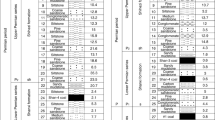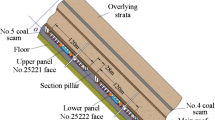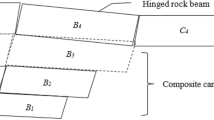Abstract
This paper presents a comprehensive analysis of roof strata conditions, shield pressure, and ground surface subsidence above Panel 42105 of the Buertai Coal Mine in Inner Mongolia, China. A 3D geological model and a 2D numerical simulation model are established to examine the roof strata structures with varying strata conditions. Numerical simulation results demonstrate that the hard rock 1 and 2 roof layers are, on average, likely to break 20 m and 57 m behind the coal face, respectively. It is concluded that when the immediate roof is relatively thin, a cantilever beam is formed, whereas a Voussoir beam is formed when the immediate roof is relatively thick. The patterns of shield pressure and surface subsidence under different roof conditions are also examined. The shield working pressure under the Voussoir beam structure appears to be lower than that under the cantilever beam structure. The average horizontal distance behind the working coal face at which the maximum surface subsidence occurs is 92.1 m. On-site monitoring data are used to explain the causes of the unusual shield pressure and its relation to surface subsidence. Finally, guidelines to predict the shield pressure under similar conditions are provided.


















Similar content being viewed by others
Abbreviations
- Δhi :
-
Subsidence of hard rock
- Δmax :
-
Limiting subsidence of hard rock
- m :
-
Mining height
- K p :
-
Bulking factor
- ∑h :
-
Sum of the thicknesses of the first to (i − 1) rock layers above the coal seam
- \({h_i}\) :
-
Thickness of ith rock layer above the coal seam
- K 1 :
-
Ratio of extrusion stress to compressive strength
- K 2 :
-
Empirical coefficient
- σ p :
-
Extrusion stress
- σ c :
-
Compressive strength
- n :
-
Ratio of compressive strength to tensile strength
- \({P_i}\) :
-
Average support pressure
- P s :
-
Setting pressure of shield
- P t :
-
Time-weighted average pressure
- σ :
-
Standard deviation
References
Alejano LR, Ramirez-Oyanguren P, Taboada J (1999) FDM predictive methodology for subsidence due to flat and inclined coal seam mining. Int J Rock Mech Min Sci 36:475–491
Chen Y, Zhang HW, Zhu ZJ, Yu B, Huo LJ (2014) Research on the law of overburden movement and failure under the influence of double period coal seam mining. Chin J Geol Hazard Contr 25(3):67–73
Cheng GM, Xu WJ, Chu HB (2014) Numerical modeling of soil–pipeline interaction mechanism caused by surface subsidence due to longwall mining. Adv Mater Res 838–841:2202–2207
Cui XM, Xue YL, Miao XX (2000) Improved prediction of differential subsidence caused by underground mining. Int J Rock Mech Min Sci 37:615–627
Cui XM, Wang JC, Liu YS (2001) Prediction of progressive surface subsidence above longwall coal mining using a time function. Int J Rock Mech Min Sci 38:1057–1063
Du F, Bai HB (2013) Mechanical analysis of immediate roof in fully mechanized top coal caving mining with thin bedrock. J China Coal Soc 38(8):1331–1337
Hao BB, Wang CH, Luo F (2015) Study of surface subsidence law based on key stratum theory. Coal Technol 34(4):127–129 (in Chinese)
Huang QX (2000) Study on roof structure and ground control of longwall mining in shallow coal seam. China University of Mining and Technology Press, Xuzhou (in Chinese)
Jiang DJ (2015) Research on overburden structure and shields stability of fully mechanized top coal caving mining face with large mining height (Ph.D. dissertation). Henan Polytechnic University, Jiaozuo (in Chinese)
Jirankova E (2012) Utilisation of surface subsidence measurements in assessing failures of rigid strata overlying extracted coal seams. Int J Rock Mech Min Sci 53:111–119
Ju JF, Xu JL (2015) Surface stepped subsidence related to top-coal caving longwall mining of extremely thick coal seam under shallow cover. Int J Rock Mech Min Sci 78:27–35
Ju Y, Liu P, Chen JL, Yang YM, Pathegama G. Ranjith (2016) CDEM-based analysis of the 3D initiation and propagation of hydrofracturing cracks in heterogeneous glutenites. J Nat Gas Sci Eng 35:614–623
Li HM, Jiang DJ, Li DY (2014) Analysis of ground pressure and roof movement in fully-mechanized top coal caving with large mining height in ultra-thick seam. J China Coal Soc 39(10):1956–1960
Lian XG (2016) Prediction model of dynamic subsidence caused by underground coal mining. Electron J Geotech Eng 21:6057–6068
Liu Y, Dai H, Jiang Y (2012) Model test for mining-induced movement law of rock and soil mass under thick unconsolidated layers. J Min Saf Eng 29:268–272
Liu C, Li HM, Mitri HS, Jiang DJ, Li HG, Feng JF (2017a) Voussoir beam model for lower strong roof strata movement in longwall mining—case study. J Rock Mech Geotech Eng 09(6):1171–1176
Liu C, Li HM, Jiang DJ (2017b) Numerical simulation study on the relationship between mining heights and shield resistance in longwall panel. Int J Min Sci Technol 27(2):293–297
Marschalko M, Bednarik M, Yilmaz I, Bouchal T, Kubecka K (2011) Evaluation of subsidence due to underground coal mining: an example from the Czech Republic. Bull Eng Geol Environ 71:105–111
Peng SS (2011) Longwall mining. Science Press, Beijing, pp 131–138
Peng SS (2013) coal mine ground control. China University of Mining and Technology Press, Xuzhou, pp 310–312
Qian MG, Shi PW, Xu JL (2010) Mining pressure and strata control. China Mining University Press, Xuzhou (in Chinese)
Ren W, Guo C, Peng Z, Wang Y (2010) Model experimental research on deformation and subsidence characteristics of ground and wall rock due to mining under thick overlying terrane. Int J Rock Mech Min Sci 47:614–624
Richards DR, Jones NL (1997) Conceptual model approach to modeling groundwater with GMS. In: Proceedings, congress of the international association of hydraulic research, IAHR, C, pp 325–330
Sasaoka T, Takamoto H, Shimada H, Oya J, Hamanaka A, Matsui K (2015) Surface subsidence due to underground mining operation under weak geological condition in Indonesia. J Rock Mech Geotech Eng 7:337–344
Suchowerska AM, Carter JP, Hambleton JP (2015) Geomechanics of subsidence above single and multi-seam coal mining. J Rock Mech Geotech Eng 8:304–313
Wang HT, Zhao BC, Wang JD (2014) Study on the coefficient of surface subsidence by mining on the condition of thick unconsolidated layers and thin stratum. App Mech Mater 448–453:3873–3878
Xu JL, Qian MG (2000) Study on influence of key strata movement on subsidence. J China Coal Soc 25(2):122–126 (in Chinese)
Xu JL, Qian MG, Zhu WB (2005) Study on influences of primary key stratum on surface dynamic subsidence. Chin J Rock Mech Eng 24(5):787–791 (in Chinese)
Xu JL, Lian GM, Zhu WB, Qian MG (2007) Influence of key strata on mining subsidence in deep mining. J China Coal Soc 32(7):686–690 (in Chinese)
Yu GM, Sun HQ, Zhao JF (2001) Fractal increment of dynamic subsidence of the ground surface point induced by mining. Chin J Rock Mech Eng 20(1):34–37 (in Chinese)
Zhang H, Li L, Liu Z, Fu LF (2012) Application of surfer 8.0 in earthwork calculations and accuracy analysis. Adv Mater Res 446–449:3295–3298
Zhao H, Ma F, Xu J, Guo J (2012) In situ stress field inversion and its application in mining-induced rock mass movement. Int J Rock Mech Min Sci 53:120–128
Zhou DW, Wu K, Cheng GL, Li L (2015) Mechanism of mining subsidence in coal mining area with thick alluvium soil in China. Arab J Geosci 8:1855–1867
Zhou DW, Wu K, Li L, Diao XP, Kong XS (2016) A new methodology for studying the spreading process of mining subsidence in rock mass and alluvial soil: an example from the Huainan coal mine, China. Bull Eng Geol Environ 75:1067–1087
Acknowledgements
The authors wish to acknowledge the contributions of Prof. JF Chen, Associate Prof. CS Song and F Du, and Mr. C Wang and JL Zheng, among others. This research is funded by the National key special projects no. 2018YFC0604500 and Chinese Natural Science Committee under Grant no. U1261207. The authors are grateful for their support.
Author information
Authors and Affiliations
Corresponding author
Additional information
Publisher’s Note
Springer Nature remains neutral with regard to jurisdictional claims in published maps and institutional affiliations.
Rights and permissions
About this article
Cite this article
Liu, C., Li, H. & Mitri, H. Effect of Strata Conditions on Shield Pressure and Surface Subsidence at a Longwall Top Coal Caving Working Face. Rock Mech Rock Eng 52, 1523–1537 (2019). https://doi.org/10.1007/s00603-018-1601-3
Received:
Accepted:
Published:
Issue Date:
DOI: https://doi.org/10.1007/s00603-018-1601-3




